Pueblo, CO Pollen and Allergy Report for Summer 2023
Pollen Allergy Trends in Pueblo, CO
When is pollen lowest in Pueblo, CO?

February
Lowest month total PPM
Avg. PPM
When is pollen highest in Pueblo, CO?

March
Highest month total PPM
Avg. PPM
How does pollen in Pueblo, CO compare to Colorado?
Pueblo has a lower average PPM than the state of Colorado.
Pueblo yearly avg PPM:
Colorado yearly avg PPM:
How does pollen in Pueblo, CO compare to the USA?
Pueblo has a lower average PPM than the USA.
Pueblo yearly avg PPM:
USA yearly avg PPM:
Is pollen worse this year in Pueblo, CO?
Spring 2023 was worse than spring 2022.
Spring 2023 PPM:
Spring 2022 PPM:
Average PPM in Pueblo, CO
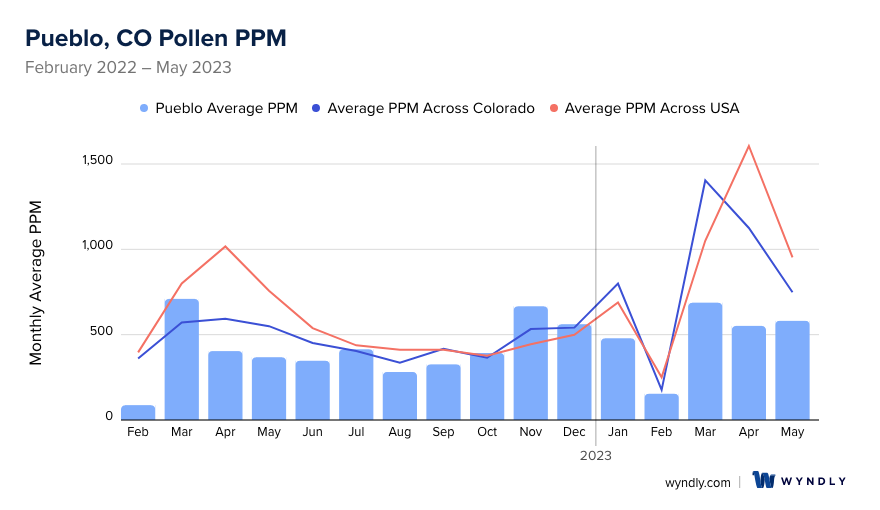
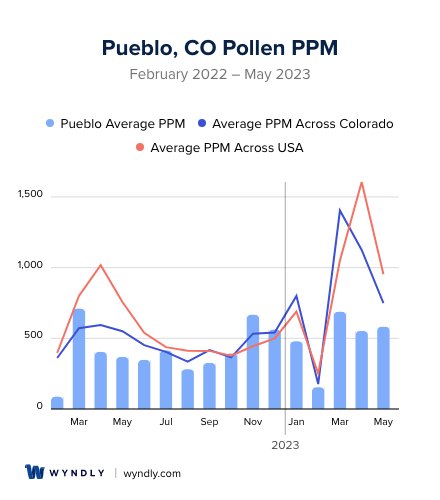
Pueblo, CO Pollen and Allergy Breakdown by Month
Grass
When is grass pollen highest in Pueblo, CO?
May has the highest grass pollen in Pueblo, CO with an average PPM of
When is grass pollen lowest in Pueblo, CO?
April has the lowest grass pollen in Pueblo, CO with an average PPM of
Tree
When is tree pollen highest in Pueblo, CO?
March has the highest tree pollen in Pueblo, CO with an average PPM of
When is tree pollen lowest in Pueblo, CO?
May has the lowest tree pollen in Pueblo, CO with an average PPM of
Weed
When is weed pollen highest in Pueblo, CO?
November has the highest weed pollen in Pueblo, CO with an average PPM of
When is weed pollen lowest in Pueblo, CO?
February has the lowest weed pollen in Pueblo, CO with an average PPM of
Pueblo, CO Pollen Monthly Breakdown by Pollen Type
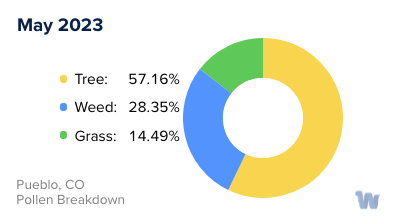
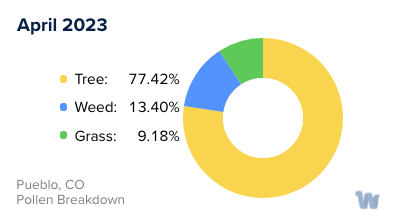
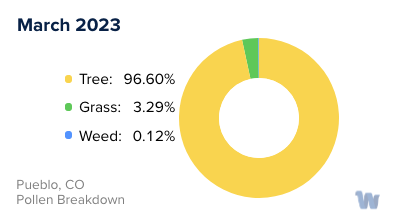
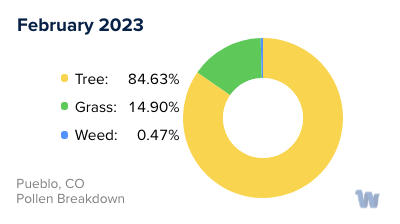
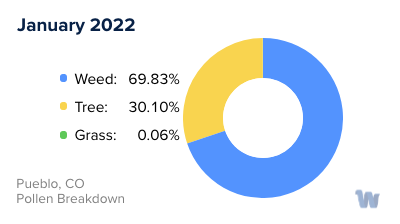
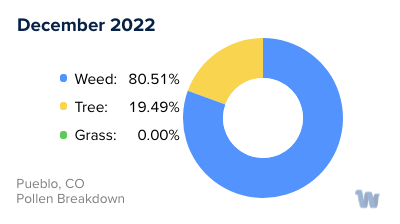
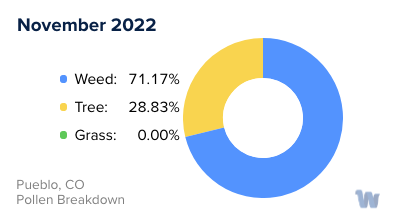
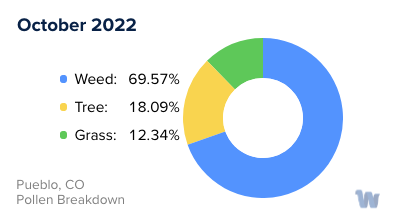
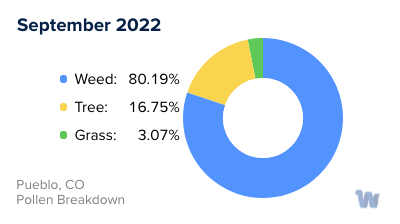
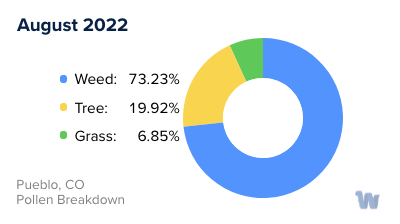
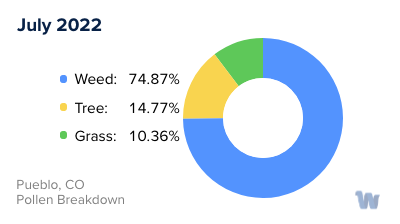
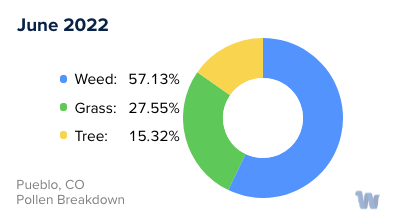
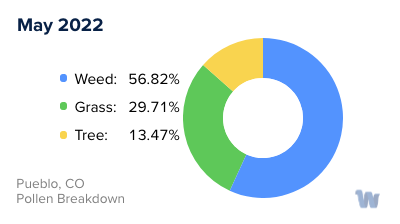
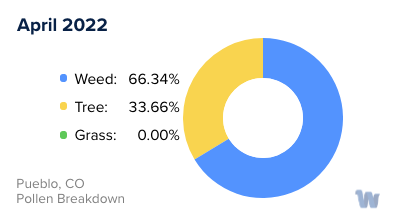
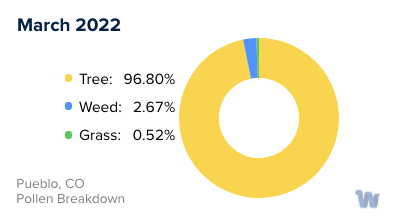
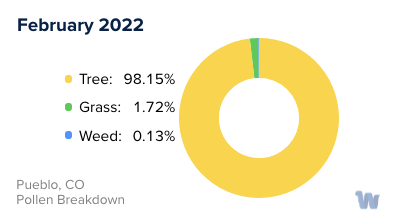
Pollen and Hay Fever in Pueblo, CO
Pueblo, Colorado is a vibrant city that's home to a diverse range of flora. The city's climate and lush vegetation make it a haven for trees, grass, and weeds, which flourish year-round. Unfortunately, for those with pollen allergies, this also means an extended allergy season that begins in February and starts to ebb in November.
Pollen from various trees significantly contribute to the allergies in Pueblo. The winter months see the pollination of Juniper, or Cedar, trees, notorious for causing severe symptoms of allergic rhinitis. As we usher in the spring, Cottonwood and Aspen trees unfurl their flowers, spreading pollen across the state. This period, beginning in February and lasting until May, often brings challenges for those prone to allergies. Elm trees, particularly prevalent around the river and Lake Pueblo, also join the pollinating ensemble during this time. With Oak trees entering their pollination phase in the spring, this season truly tests the mettle of allergy sufferers in Pueblo.
As spring gives way to summer, the spotlight shifts to grass pollen, which is the most common allergen in the United States and a significant trigger for hay fever. Ryegrass and Kentucky Bluegrass, a common sight in Pueblo's lawns, release copious amounts of pollen from spring to early fall, with the peak period occurring between March and May.
When it comes to weeds, Pueblo sees its worst during August. However, windy and dry conditions can cause weed pollen levels to surge at any time of year. Sagebrush, which flowers from mid-August to late September, is particularly bothersome for those with asthma allergies, as the tiny particles can irritate the throat. Tumbleweed, prevalent during storms or high winds, begins to stir up trouble from July to October. Lastly, if you find yourself grappling with allergies between July and September, you're likely encountering the infamous ragweed.
In conclusion, understanding the types of pollen and their seasons in Pueblo can help residents and visitors anticipate and prepare for these allergy-inducing periods.

